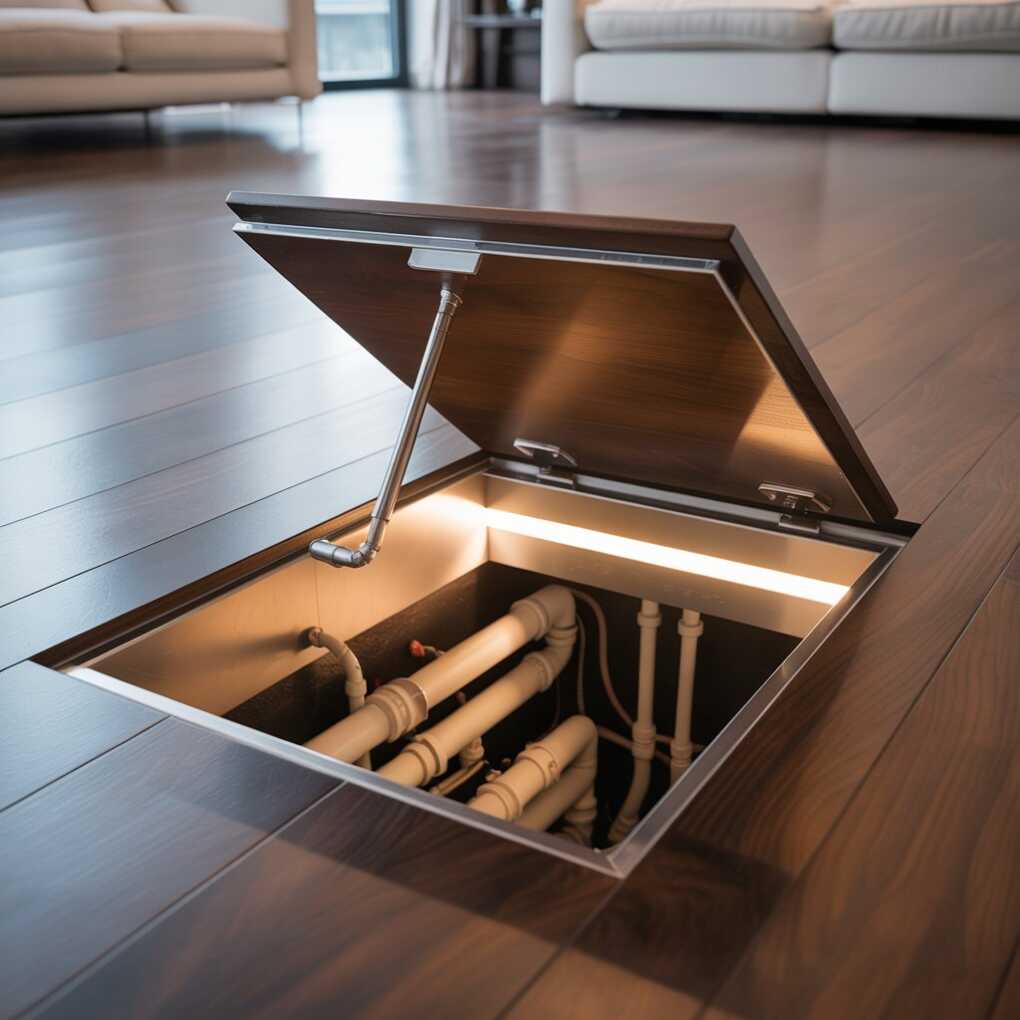Whether you’re remodeling a home or upgrading a space, easy access to hidden systems is essential for a smooth renovation process. One straightforward and effective solution is a floor access hatch.
These versatile panels offer quick access to important utility areas, such as electrical and plumbing systems, without compromising the space’s design or outlook.
For routine maintenance or emergency repairs, easy floor-level access can reduce time, labor, and costly disruptions.
For general contractors and renovation specialists, floor hatches are a smart, future-proof investment that improves the long-term serviceability of any building.

The Purpose of Floor Access Hatches
A floor access hatch provides convenient, non-disruptive entry to areas beneath the floor. When paired with other access doors and panels, it creates a complete access solution that meets today’s construction demands.
This functionality results in multiple benefits that impact renovation efficiency and design.
Provide Easy Access To Hidden Utility Systems
Plumbing lines, electrical conduits, HVAC ductwork, data cables, and even complex smart home wiring often run beneath floors, out of sight. While this keeps interiors clean and uncluttered, it presents a challenge when these systems require maintenance, repairs, or upgrades.
Instead of cutting into finished flooring or structural elements, a pre-installed hatch offers a designated entry point. Workers can reroute a drainpipe in a bathroom renovation, upgrade electrical wiring in an old commercial building, or install new fiber optic cables with minimal disruption.
Save Time and Labor During Renovations
Traditional methods of accessing under-floor utilities are labor-intensive and time-consuming. Imagine the effort involved in removing hardwood flooring, cutting through subflooring, and repairing everything afterward.
This process not only requires skilled labor but also creates significant disruption.
Floor access hatches eliminate much of this work. Workers can get in and out of utility areas quickly, diagnose issues faster, and complete repairs or upgrades without hassle. This is especially helpful in commercial spaces where downtime impacts daily operations.
Roof hatches simplify routine maintenance for residential projects, such as checking sump pumps or repairing underfloor heating systems. In both cases, hatches help keep renovations on schedule and within budget.
Support Clean, Clutter-Free Designs
Beyond functionality, floor access hatches help achieve and maintain aesthetically pleasing, clutter-free designs.
Many modern hatches are designed to blend with the surrounding flooring seamlessly. They sit flush with the floor, and some can hold various flooring materials like tile, wood, carpet, or concrete.
This ensures the hatch doesn’t disrupt the room’s aesthetic even in high-traffic or visually prominent areas. The result is a clean, modern space with all the necessary practical access built right in.
Support Preventive Maintenance
Preventive maintenance is more cost-effective than emergency repairs but only works when access is easy. A floor access hatch encourages regular inspections, especially in hard-to-reach places like crawl spaces or subfloors.
When access is convenient, building managers and homeowners are more likely to stay on top of upkeep, leading to fewer costly surprises.
Enhance Property Value
A well-maintained building retains its value longer. By installing thoughtful features like floor hatches, contractors add long-term usability that appeals to both current owners and future buyers.
Choosing the Right Floor Hatch for the Project
When choosing a floor access hatch, think about the project’s specific demands. Consider the type of flooring, expected load, and necessary security.
Material
Hatches are available in various materials such as aluminum and steel, each suited for different flooring types and environments. Ensure the hatch material is compatible with the surrounding floor finish for a seamless look and long-term durability.
Load-Bearing Capacity
For commercial buildings like schools, hospitals, or retail stores, floor hatches must withstand heavy foot traffic, and sometimes, even rolling equipment. Steel or aluminum hatches with reinforced frames and slip-resistant covers are ideal in these environments.
Residential applications might have less stringent requirements. However, it’s still important to consider the potential weight the hatch will bear.
Aesthetics and Finish Options
As mentioned, the hatch’s ability to blend with adjacent flooring material is important for design. Many hatches come ready to accept a variety of floor finishes, allowing them to disappear almost entirely into the floor.
Sealing and Insulation
A sealed or insulated hatch is essential in areas where moisture, odors, or temperature control are concerns (e.g., basements, crawl spaces, or specific commercial applications). This prevents unwanted air or moisture transfer and contributes to energy efficiency.
Safety and Code Compliance
Safety is a top concern in both residential and commercial settings. To prevent trip hazards, floor access hatches must be flush and locked securely to avoid unauthorized access or accidental openings.
Ensure the hatch complies with local building codes, especially in commercial environments where ADA compliance or fire ratings may apply.
If the hatch provides access to sensitive areas or valuable equipment, consider models with locking mechanisms or tamper-resistant designs.
Conclusion
A floor access hatch is more than just a utility panel for general contractors and renovation professionals. It’s a strategic tool that saves time, simplifies upgrades, and supports modern design.
Whether in a residential remodel or a commercial upgrade, these hatches provide safe, discreet, and efficient access to essential systems hidden beneath the floor.
By choosing the right hatch for the job and factoring it into the early planning stages, professionals can boost the quality of their projects and provide lasting value for their clients.
